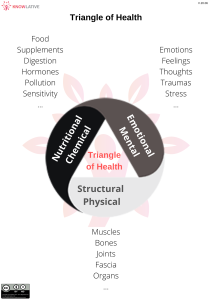This is a key concept in Applied Kinesiology and in many other branches of Specialized Kinesiology and represents a particular vision of Health.
The Triangle of Health is a holistic approach which presents the Mental/Emotional, Structural and Biochemical aspects of our being as equal sides of a triangle. When the triangle is equilateral, the sides are balanced and the person is in a state of wellness. But our body is constantly stressed by everyday life and the triangle can be altered in one of its aspects. Any change in one of the 3 aspects also affects the other 2 sides of the triangle.
In this vision, Health is the result of the balanced activity of 3 main areas or functions of the body and they are compared to the 3 sides of a triangle:
- Structure: this side comprehends what happens in bones, tendons, muscles, fascia, skin, … from a structural point of view.
- Biochemistry/Nutrition: this side comprehends all aspects related to substances we ingest or inhale and with all biochemical pathways of the body.
- Emotions/mind: this side is related to all mental and emotional activities. Since mind and emotions are 2 very different sets of body functions, some Specialized Kinesiology branches, like Touch for Health, divide this in 2 different sides changing the metaphor from a triangle to a pyramid.
For example, if a person is under Mental/Emotional stress, the related side will become altered, and this will impact both the Biochemical and Structural aspects of the person. When you are stressed emotionally, you might make poor food choices and be unable to metabolize your food well (Biochemical). At the same time, you may find you are slumped over with poor posture and neglect to exercise (Structural). This means that we can have many Biochemical and Structural symptoms, but the real cause can be Mental/Emotional.
Kinesiology is a holistic approach and it looks for the real causes rather than treating the symptoms. The great advantage that Kinesiology has, compared to other methods, is that the Kinesiologist, through the use of the Muscle Response Testing, can find the primary disorder even if the symptoms are in a different side of the triangle.

